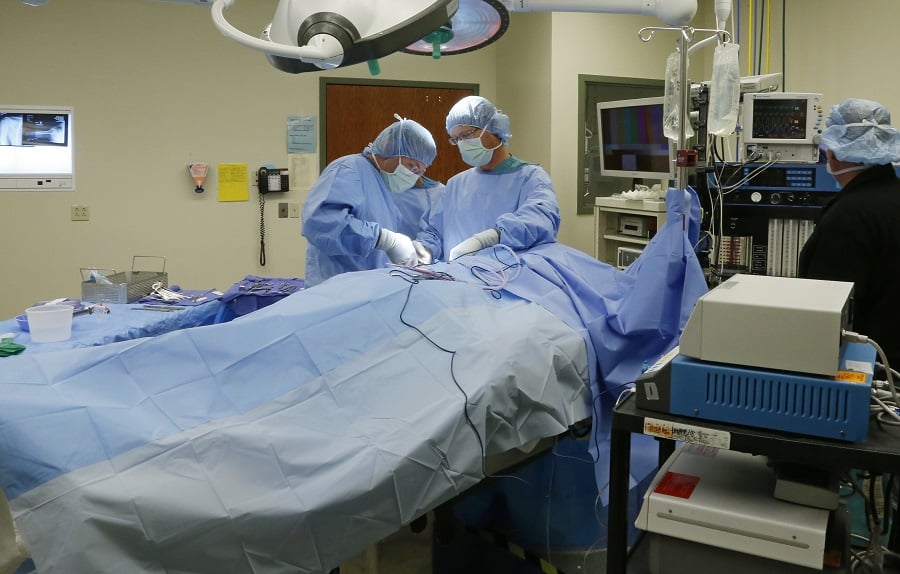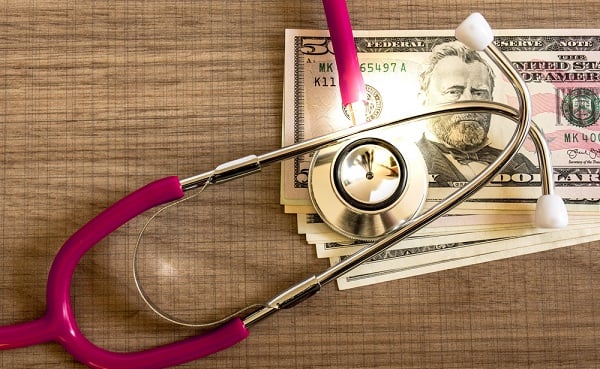 Recently, my wife wentto the doctor with stomach issues. The doctor recommendeda simple diagnostic test called a HIDA scan. We have anHSA high-deductible health insurance plan with a $6,450 deductible,meaning we would be paying for the procedure out-of-pocket untilour deductible was met.
Recently, my wife wentto the doctor with stomach issues. The doctor recommendeda simple diagnostic test called a HIDA scan. We have anHSA high-deductible health insurance plan with a $6,450 deductible,meaning we would be paying for the procedure out-of-pocket untilour deductible was met.
Before my wife left the doctor's office, she asked thereceptionist what she thought was a simple question: “How much isthis going to cost?”
|The receptionist had no idea — and she had no way tocheck. She looked at my wife like it was an unreasonablequestion. A manager contacted a third-party billingagency to get her a quote, which ended up being nothing close towhat we actually paid in the end.
|Economic models assume participants have perfect information. In reality, they often have no informationwhatsoever.
|Because I am a population health manager, i.e., employeebenefits consultant, so I have access to transparency solutions that aren't readilyavailable to the average consumer. See the findings below:
|
There are several observations that are noteworthy:
- If I had done this research myself, I would still be obtainingthis data|
- Our secret weapon supplied this data in less than 24 hours
- Insurance contracted prices/rates ranged all over the map, from$1,125 to $2,085
- Cash rate was higher than the insurance prices with Emory andPiedmont?|
- How can this be? Can this be right?
- Pricing could not be obtained from the Emory Clinic|
- Why? Do they not need business? Do they not want tocompete?
- Cash rate could not be obtained from Northside Hospital|
- Why? Is this a complicated request?
- The best price was $450 at DeKalb Medical Center, which iswhere we went.
I also researched pricing at nationally renowned HealthcareBluebook, which provides free online tools designed to enableconsumers to understand the fair price they should pay for healthcare services in a certain area. It came up with a price of$798.
|I thought this was a glaring example of how screwy health carepricing is, but I had no idea.
|A permanent pacemaker implant at Pennsylvania's PhoenixvilleHospital is billed at $211,534. Four hours away at UnitownHospital, the same procedure costs $19,747, or 91 percent less.Over 160 hospitals across the country charge at least $100,000 fora pacemaker, while 46 charge less than $30,000.
|The official bill rate to treat chronic obstructive pulmonarydisease, or COPD, at Bayonne Hospital Center in New Jersey, is$99,690. At Lake Whitney Hospital in Texas, it's $3,134, or 97percent less. Thirty-five hospitals bill an average of more than$50,000 to treat COPD, while 161 bill less than $7,500.
|A kidney and urinary tract infection faces a $132,569 bill atCrozer Chester Medical Center in Pennsylvania, but $6,224 atWyoming County Community Hospital.
|Those are just a few examples I pulled out of a massive databasereleased by the Centers for Medicare and Medicaid Servicesin April 2015. The group spilled the beans on what 3,000hospitals charge for 100 of the most common medical procedures. Itthen compares those “chargemaster” prices to what Medicare actuallypaid for the treatments, based on hospital-specific estimates ofthe treatment's cost, including administrative overhead.
|The database — which contains nearly 1 million data points andcrashed my computer three times — has two screaming-in-your-facetakeaways.
|The first is the difference between bill rates among hospitals.It's just huge. At least a dozen treatments I looked up have adifference between the high-cost and low-cost provider of more thanten-fold, and several treatments will cost more than 20 times asmuch, depending on what hospital you're in.
|The report doesn't contain perhaps the most important metric:outcomes and quality of procedures performed. Teachinghospitals and hospitals that receive an influx of seriously illpatient transfers from other hospitals will also havehigher-than-average costs.
|But even looking at average prices by state shows massivediscrepancies. In California, the average hospital charges $101,844to treat respiratory infections, while Maryland hospitals bill anaverage of $18,144, or 82 percent less. New Jersey hospitals billan average for $72,084 for “simple pneumonia,” while Massachusettshospitals charge an average of $20,722.
|The second takeaway is that the gap between what hospitalscharge for procedures and what Medicare actually pays for thoseprocedures is off the charts. Of the 100 procedures tracked in thedatabase, the average difference between “average charges” and“average payments” is — I'm not making this up — 72 percent.
|Related: Jury deems Centura Health $230K surgical bill'unreasonable,' awards $766
|Go back to my pacemaker example above. Phoenixville Hospital maycharge $211,534 for a pacemaker implant, but Medicare pays thehospital $17,835 for the procedure. Unitown Hospital bills $19,747for the treatment, and is reimbursed $15,281. What startsout as a five-fold price discrepancy shrinks to a 14 percentdifference in the end.
|Steven Brill, a journalist who wrote an eye-opening cover storyfor TIME in February 2013 (the longest article in the history ofTIME) exposing discrepancies in health care bill prices that pavedthe way for the data's release, wrote:
|The hospital lobby, led by the American HospitalAssociation, is going to howl that publication of thesechargemaster prices is unfair. Only a minority ofpatients are actually asked to pay those amounts, it will argue. Insurance companies, which cover the majority ofpatients, receive huge discounts off the list prices, though theypay substantially more than Medicare does.
|True, but that doesn't settle the matter. It actually highlightssome of the deepest problems. Those “minority ofpatients” are no small group; they're the estimated 48 millionAmericans without health insurance. For medical providersto say that chargemaster prices don't reflect the true cost of careis to admit that some of the most financially vulnerable Americansmay be being billed absurdly inflated prices. It'sironic, but some of the greatest benefits to having healthinsurance aren't necessarily the insurance coverage, but theprice-negotiating power that insurance companies strike with careproviders. At least that is what they tell you. But as we have seen with my wife, the insurance companies aren'tdelivering as advertised; getting a 50 percent discount off thechargemaster price of an item that costs $13 and lists for $199.50is still no bargain. In our research, cash was the leastexpensive as well as the most expensive — truly a box ofchocolates.
|Imagine a banana in a supermarket. It costs $1 forthose paying with Visa, $3 for those paying with MasterCard, and$32 for those paying with cash. You can't sign up forVisa until you're 65, and you can only get a MasterCard if you havea nice employer or a decent income. Worse, customers haveno idea that such price discrepancy exists. They don'teven know how much they'll pay for the banana until long afterthey've eaten it.
|That would be absurd. No one would put up with it.
|“There is no such thing as a legitimate price foranything in health care, prices are made up depending on who thepayer is. So, the fact that different prices are paid bydifferent payers is not what makes health care different — not inthe slightest. What makes it different is that the payer is not theconsumer, but the payer is the employer, the government, or aninsurer.” George Halvorson, former chariman of KaiserPermanente
|But it's how our health care system works.
|It appears that our crazy system of hospital prices (and theinefficiency that accompanies it) is not natural orinevitable. Instead, what we have appears to be theproduct of a system in which someone other than the patient paysthe bill.
|Where else in America is the person utilizing the services notpaying for 100 percent of what they are purchasing? As I like to say, the purchase of medical goods andservices by employer health plans resembles no otherbusiness transaction in American commerce.
|An employer must embrace our simple solution to this problem,which is to move toward paying for medical goods and services inthe same manner that the corporation buys everything else — withtransparency and with upfront knowledge of the cost. Wefirmly believe that unless employers put their claims costs back inthe box using this proprietary strategy that cracks the code, theywill never move the needle in reducing their claims cost.
|About the Author: Carl C. Schuessler,DHP, DIA, GBDS is the managing principal of MitigatePartners, who provide risk management, costcontainment and employee benefits consulting services. Byserving as a fiduciary and steward of clients' health plan dollars,and focusing on how to reduce the cost of healthcare (rather thanthe cost of insurance), they operate as population health managersrather than as “brokers.” They created and trademarked FairCo$t, ahealth plan that incorporates the ideas and the high performancehealth care solutions their journeyuncovered.
Complete your profile to continue reading and get FREE access to BenefitsPRO, part of your ALM digital membership.
Your access to unlimited BenefitsPRO content isn’t changing.
Once you are an ALM digital member, you’ll receive:
- Critical BenefitsPRO information including cutting edge post-reform success strategies, access to educational webcasts and videos, resources from industry leaders, and informative Newsletters.
- Exclusive discounts on ALM, BenefitsPRO magazine and BenefitsPRO.com events
- Access to other award-winning ALM websites including ThinkAdvisor.com and Law.com
Already have an account? Sign In






